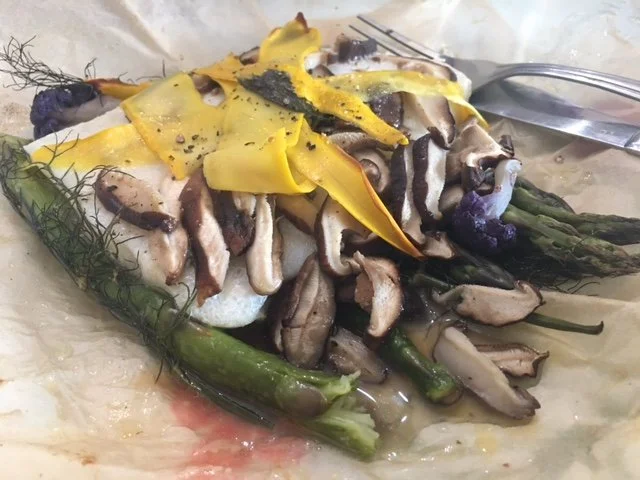Girl Scout Cooking
From Brownies to Seniors, I was a Girl Scout. During the school year it was weekly troop meetings, but when summer arrived I was all about day camp and when I got older, sleepaway camp. I hiked, rode horses, canoed, made braided lariats, and stamped leather coin purses. Fires were lit without matches or lighters using an assortment of methods such as flint and steel, magnifying lenses, and bow drill. While many of those skills are no longer part of my summer activities, the one thing that has carried on throughout the years is my favorite camp cooking method of packet meals.
Weren’t in Scouts? No problem. This is so easy even kids can do it. Maybe that’s why it was so popular every time we went camping.
Troop leaders would divvy up a roll of heavy duty aluminum foil in squares to each scout. We were each tasked with bringing an assigned vegetable which were all spread out on a folding table from where everyone could choose what they wanted in their own meal packet before we folded the into closed envelopes and placed them over the fire to cook. Much to the amazement of my counselors on a canoe trip, I caught fish each day, cleaned them and cooked them in foil each night during a week-long trip down the Susquehanna River. No hot dogs for this fisherman’s daughter.
My Scouting days are behind me, but with the abundance of colorful vegetables in season, prepping up a handful of foil packets for a week’s worth of meals is the easiest way to take advantage of fresh, local foods. Communal campfires have given way to personal fire pits and fancy deck chimineas. Even a regular ol’ charcoal or gas grill will do. A few years ago when my stove crapped out and the replacement took a week to arrive, it was fun to see how creative I could get with my foil packet cooking. A mound of vegetables, a dollop of coconut cream, a spoonful of peanut butter, a spoonful of green curry paste and a few big shrimp yielded a restaurant worthy meal.
Entertaining? This method offers more time with your guests thanks to not just easy prep work, but also quicker clean up—less pots & pans.
If smoke, fire, and outdoor cooking isn’t your thing you can use a regular indoor oven to do the cooking. Want a more elegant presentation? Trade the aluminum foil for parchment paper. Fair warning—don’t use this method around open flames or you’ll be unexpectedly ordering pizza.
Parchment packets can turn the most timid kitchen mouse into a masterful gourmet with only a few ingredients from the farmers market. This is my go-to dinner for a nice piece of fish. You absolutely can not make bad fish in parchment unless you get it too close to a flame and set the whole thing on fire.
Be prepared for escaping steam no matter which type of packets used or you’ll be practicing for your first aide badge by nursing a steam burn.

